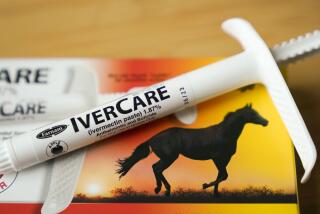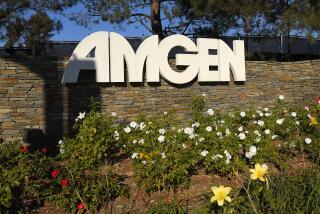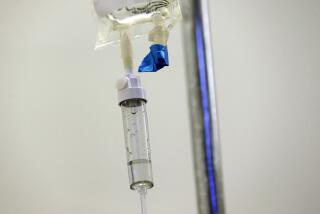Amgen facing ill winds
- Share via
Amgen Inc., the Thousand Oaks-based biotech behemoth, has been a shining star in the drug industry for more than two decades. Recently, it isn’t burning so brightly.
This morning, Congress begins hearings about cost and safety concerns around two of the company’s top-selling drugs, Epogen and Aranesp, which are used to treat nearly 2 1/2 million dialysis and cancer patients with anemia in the U.S. each year.
Last month, two research studies in the New England Journal of Medicine found those who received higher doses of anemia drugs die or suffer heart attacks and strokes more often than patients who received lower doses.
Should lawmakers signal that they want to curtail the amount of anemia drugs doctors prescribe -- which the federal government could do by lowering reimbursement rates through Medicare -- it would clearly pose a significant threat to Amgen’s bottom line. The company’s anemia lineup makes up almost half of its sales and 60% of its profit.
Such a move would be the latest in a string of negative events for the company. Some of Amgen’s most important international anemia patents have recently expired, and its domestic one will probably follow in just a few years. And the newly Democratic-controlled Congress has signaled it may soon introduce legislation to allow generic competition in the biotech industry, something the federal government hasn’t done before.
Meanwhile, the company is under attack from a host of competitors that threaten to do more than just nip at its heels. At the top of the list is Swiss drug maker Roche Holding, which has developed its own anemia drug, Cera, which could get federal approval as early as next year. Amgen has filed a patent infringement suit and a court case is expected in a few months; it’s anyone’s guess who will prevail.
Perhaps most worrisome is the strength of Amgen’s once-storied research pipeline. Some analysts say Amgen is having more difficulty than its competitors in finding new blockbusters to ensure the robust sales growth it has long been known for, especially in the oncology sector, the biotech industry’s most lucrative field.
That may be why the company’s stock has languished. Although the Amex index of 20 major biotech stocks is up 14% this year, Amgen’s stock has declined 12%.
“I don’t see much reason to think they’re going to get the kind of momentum they had a few years ago anytime soon,” said James Reddoch, a biotech analyst with Friedman Billings Ramsey.
It’s possible the company could surprise its skeptics and the industry. After all, since the company was founded in 1980, it has grown into the world’s largest biotechnology company and boasts one of the biggest stock market values of any drug company. Last year, Amgen earned $3.7 billion on revenue of $12.4 billion.
With the company having cash to spare, executives have the means to find and acquire heaps of new drugs. Several of the company’s products are in late-stage clinical trials, and its recent acquisition of Fremont, Calif.-based Abgenix, which has several promising monoclonal antibodies to treat cancer and other diseases, could eventually pay off handsomely.
Willard Dere, Amgen’s senior vice president of global development and chief medical officer, said the company was investing $3 billion in research this year and was confident about the number and quality of drugs it has on the market or in clinical trials. Among them: a new colon cancer drug, Vectibix, that came on the market this fall. Several possible breakthrough therapies for osteoporosis, cancer and other diseases could be on pharmacy shelves as early as 2009.
“Our portfolio is filled with novel targets, not me-too drugs,” Dere said, referring to the trend among pharmaceutical companies to make copycat versions of available drugs that don’t provide significant clinical gains.
But confidence is one thing; results are another. And the company must deal with current challenges. The two New England Journal of Medicine trials have created a firestorm of controversy around the firm and its chief anemia products, Epogen and Aranesp. Aranesp is a longer-acting version of the drug.
Anemia is a condition in which people don’t produce enough red blood cells, or hemoglobin, increasing their risk of infections, stroke and death. Amgen’s erythropoietin, the basis for its anemia products, stimulates bone marrow to produce red blood cells. Johnson & Johnson markets the same drug under the name Procrit, although it is produced by Amgen.
A healthy adult has a hemoglobin level around 15 grams per deciliter. The . Food and Drug Administration recommends doctors prescribe dosage to anemic patients so that they have a hemoglobin level of 10 to 12 grams per deciliter.
One of the studies in the New England journal found patients given higher doses of the drug to increase their hemoglobin levels to 13.5 grams per deciliter were more likely to die, have a heart attack or stroke or be hospitalized than patients treated to produce moderate hemoglobin levels of 11.3 grams per deciliter.
Physicians say providing medication in excess of those recommendations is common, especially with patients who are on dialysis. Indeed, a recent study published in the journal Health Affairs found the average Epogen dose quadrupled between 1991 and 2003.
Still, a panel of doctors with the National Kidney Foundation this year further changed its anemia drug dosing recommendations, which many doctors strongly take into account, suggesting it was safe to provide patients with up to 13 grams per deciliter.
Amgen and some doctors say the shift toward more aggressive dosing is justified because growing clinical evidence supports more assertive treatment.
Dr. Allen Nissenson, a nephrologist and director of UCLA’s dialysis unit, said the current FDA treatment guidelines might not be aggressive enough, pointing out that its lower hemoglobin limit of 10 grams per deciliter is below what most doctors believe is appropriate.
Critics, including other doctors and powerful lawmakers including Rep. Bill Thomas (R-Bakersfield), chairman of the House Ways and Means Committee, suggest that the uptick in doses in recent years has less to do with medicine than money -- and that the worrisome trend is lining physicians’ and Amgen’s pockets.
Currently, dialysis centers make most of their money on the premium they charge patients, or the federal government, for anemia drugs, not on dialysis services. Nephrologists also make money on the pricing arrangement. Because most dialysis centers in the U.S. are paid for by Medicare, the payment structure is nearly universal in the industry.
Critics say that incentive is the main reason patients are getting more medication. They also claim industry money is why the National Kidney Foundation upped its recommendations.
Amgen partially funds the National Kidney Foundation and research conducted by many top doctors in the industry.
“It makes no sense to have a payment system that encourages doctors to prescribe more medication than may be safe for patients,” said Dr. Daniel Coyne, a medical professor at Washington University in St. Louis. “Just as bad, many of the doctors on the [Kidney Foundation] panel have a conflict of interest to promote the drug. Do we need any more reason to worry this system is broken?”
An Amgen spokesman said the company had always advised doctors to strictly follow FDA label guidelines.
A spokeswoman at the National Kidney Foundation said Tuesday that industry support from Amgen and others did not influence the foundation’s activity or the doctors serving on its advisory panels.
“These guys [at Amgen] have historically weathered anything that gets thrown at them,” Stifel, Nicolaus & Co. analyst Edward Nash said, adding that he agrees that Amgen’s slate of drugs under development is strong. “I think they can weather this.”
More to Read
Inside the business of entertainment
The Wide Shot brings you news, analysis and insights on everything from streaming wars to production — and what it all means for the future.
You may occasionally receive promotional content from the Los Angeles Times.










